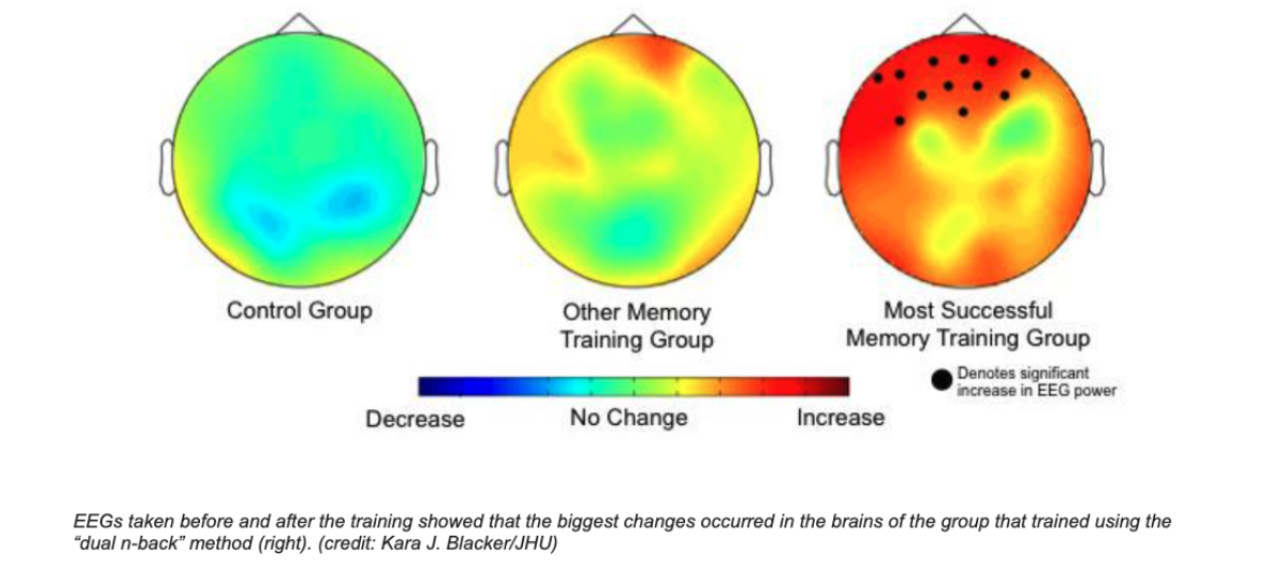Brain training is big business, with a multitude of online apps and a huge variety of exercises. It’s also a battleground of hotly contested claims. Studies appear denouncing all brain training as worthless, and these are countered by claims for every conceivable benefit from IQ increase to preventing Alzheimer’s.
In the middle of all this noise, there’s one form of training that has maintained a sturdy position as settled science. The so-called dual n-back game is a standout, because multiple studies have shown that its effects transfer to general intelligence(1). This is the holy grail of braining training — not getting better at the exercises, but improving your mental performance in the real world.
How it Works
Dual n-back is a game that challenges short-term memory. You have to recognize whether or not you’ve seen a certain stimulus one or more steps back in the game. The “n” refers to the number of steps back, which increase with difficulty. The “dual” refers to the fact that you have to look out for two different stimuli, for example visual and auditory.
The dual n-back game has been shown to improve “fluid intelligence” (inelegantly known as Gf) (2). Fluid intelligence is the ability to solve new problems without recourse to prior knowledge. It’s the skill of spotting patterns and drawing on them to create new solutions.
Space vs. Time
Why does this rather tedious and limited game have such a large impact? Clearly, to be good at dual n-back you must hold multiple factors in your mind, and you have to quickly find relations between them. More than that, the dual n-back game engages your memory. In other words, it operates through time.
What might that tell us about thinking? We have to take a little detour here. George Lakoff has done stellar work looking at how we use metaphors to navigate the world. It’s a fascinating topic, worthy of more discussion another day. Here, the question comes up: What are our metaphors for thinking itself? I’ll offer you a hypothesis, but I can’t provide the science to support it. However, you can do a little home-made experiment by watching your own mind.
I suspect that we tend to think about thinking in spatial terms. We take static snapshots of the mind as we imagine it. If we picture “lots of ideas” we see them spread out in front of us, or perhaps floating around in our brains like astronauts in the International Space Station. This kind of metaphor might help explain the huge success of mind-mapping. All those mental bits and pieces are tied together simultaneously, on one large canvas. Mind-mapping appeals because that’s what thinking “looks like” to us.
The Oldest Picture of Thought
Now here’s another image of human thought, perhaps the most universal. Writing. Take a look at any page of text, for example this one. There’s a whole lot of thinking sitting in front of you, like rows of coffee beans waiting to be roasted. If you take a mental snapshot of the page, you could say: “That’s a picture of thought.”
But take a close look. As a static wall of marks, this page is 100% dysfunctional. In a single snapshot, it doesn’t tell you anything. I don’t care how good you are at speed reading, you’ll get very little information in one brief glance — nothing compared to the same time spent looking at a photograph. Why? Because you have to read the words in sequence — even if you’re a world-class speed reader. The passage of time is essential to the mental process we call reading.
My suggestion is that what’s true of reading is true of most human intelligence. It operates through time, one thing following another, not in static collections of data. That’s why training the memory trains intelligence. “Fluid intelligence” is a metaphor, and a good one, because fluids can flow. And that’s what minds do.
1) Au, Jacky, et al. “Improving Fluid Intelligence with Training on Working Memory: A Meta-Analysis.” Psychonomic Bulletin & Review, vol. 22, no. 2, Apr. 2015, pp. 366–77
2) Blacker, Kara J., et al. “N-Back versus Complex Span Working Memory Training.” Journal of Cognitive Enhancement: Towards the Integration of Theory and Practice, vol. 1, no. 4, Dec. 2017, pp. 434–54
